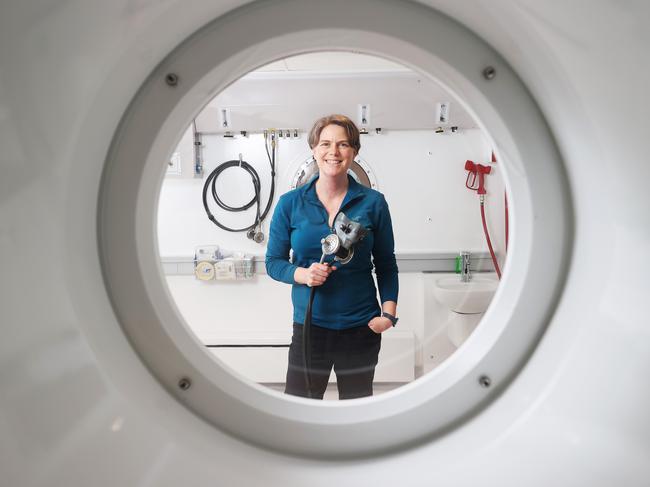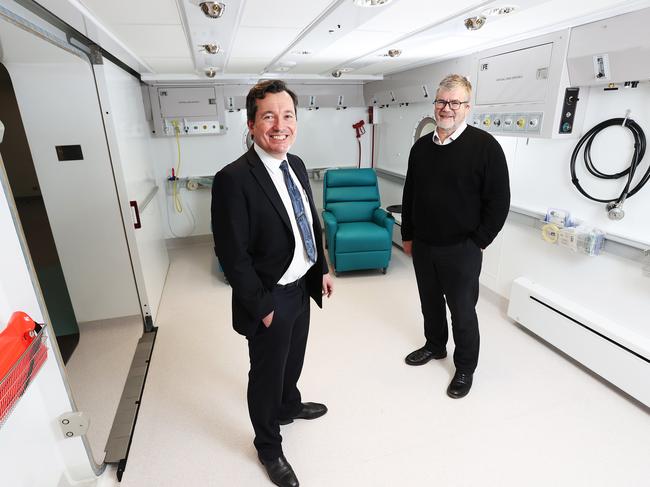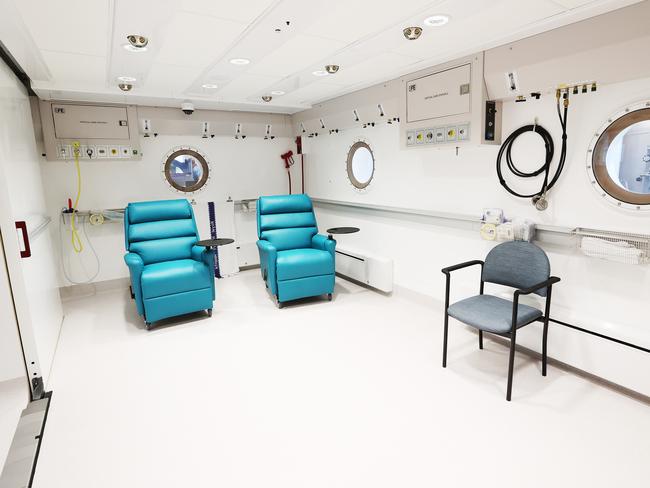No outer limits as Tasmania takes lead role in space medicine
A new hyperbaric unit at the Royal has bolstered the state’s space medicine research capabilities.
Tasmania
Don't miss out on the headlines from Tasmania. Followed categories will be added to My News.
AS NASA prepares to send humans to Mars, a mix of foresight, passion and fortunate timing has positioned Tasmania as a global leader in space medicine.
Amid the chaos of COVID-19, the Royal Hobart Hospital has gained a new $11 million hyperbaric unit, which is unique in the southern hemisphere and one of only a small number globally that can simulate high-altitude environments.
For decades, Tasmania – through the Australian Antarctic Division – has worked with NASA by using Antarctica as an “analog” for space to test everything from under-ice robots to the psychological impacts of long periods of isolation.
The new hyperbaric unit at the Royal, which is fitted with three interlocking hyperbaric chambers, bolsters the state’s space research capabilities by allowing doctors to test the impacts of extreme low-pressure environments on humans.
“Over the past couple of years we’ve seen this coalescence of capacity and expertise in Tasmania and now we have this amazing new facility, all coming together to give us a capacity that is unique in Australia,” the head of the University of Tasmania’s medical school James Vickers said.
“We are hoping to capitalise on that by working with NASA and commercial players to bring activity to Tasmania and to position ourselves as a centre of excellence for human health in space.
“A big goal of NASA is to have lots of people on bases on the moon and eventually Mars and, as we reach out into space travel, there are extremely important health considerations that everyone needs to be on top of.”
The Royal’s co-director of Hyperbaric Medicine David Cooper said the new facility can pressurise to simulate undersea depths of 50m and, at the other extreme, can depressurise to simulate an altitude of 100,000 feet (30.48km). Humans cannot withstand an altitude simulation of more than 45,000 feet without a space suit, but Professor Cooper said the extra capability allowed for testing of high-altitude equipment such as satellite and space suit components.
The hospital has had a hyperbaric unit since the late 1960s, initially to treat divers suffering decompression sickness and now also to treat diabetes-related ulcers and radiation injuries in cancer patients.
The previous hyperbaric chamber, which was nearing the end of its life, had to be replaced during construction of the hospital’s new K-Block, with extra investment to build a chamber that is both hyperbaric (high pressure) and hypobaric (low pressure).
That foresight and timing could not have been better, with the Federal Government setting up the Australian Space Agency in 2018, which was “like manna from heaven”, according to Prof Cooper, who is a hyperbaric physician and anaesthetist, but also has a degree in astronomy and astrophysics.

Late last year the State Government signed a memorandum of understanding with the Australian Space Agency, to grow and support Tasmania’s space capabilities including space medicine, ground stations and tracking facilities.
“We are now in a very strong position to become a top-tier world-leading research facility, especially with our collaborations with the university in what we call space medicine,” Prof Cooper said.
Australian Antarctic Division chief medical officer Jeff Ayton said the collaboration between the AAD and NASA went back to 1993 and was more important than ever as the US agency prepared to send humans back to the moon by 2024 and eventually on to Mars.
“As we go into the Artemis activities and lunar habitation and then going on to Mars, that’s where the Australian Antarctic analog is of real importance,” Dr Ayton said.
“There’s an opportunity now to step up to inspire the next generation of astronauts and my hope is that we will one day have an Australian doctor astronaut. If they come from Tasmania, that’s even better. That would be very inspiring.”
Tasmanian expertise that can be applied in space includes managing the health and wellbeing of Antarctic expeditioners, maintaining food supplies and the training of “lay surgical assistants” (often carpenters, plumbers and other workers who are trained at the Royal to assist in medical emergencies).

As well as running space medicine units for trainee doctors, the University of Tasmania is developing a free MOOC (massive open online course) for people around the world to learn more about the health implications of space travel.
Prof Vickers said the course will look at the risks of extreme force during takeoff, space radiation, loss of bone mass and other ways the body responds to lengthy periods of no gravity.
Gains made in space medicine, particularly in preventive and telemedicine, had broad applications on Earth, he said.
“Yes, space medicine is groovy and exciting, but what about the mammoth health issues across the board in Tasmania? What works in space is going to work on the planet as well,” Prof Vickers said.
sally.glaetzer@news.com.au
Doctor’s mission could send sons up to the stars
BY THE time her young sons have grown up, Hobart doctor Alicia Tucker believes commercial space flights for “everyday” people will be a reality.
Through her work at the Royal Hobart Hospital’s newly built hyperbaric unit, and expertise in what she calls “MacGyver medicine”, Dr Tucker wants to help make sure space tourism is as safe as possible.
“I have two boys who are six and eight and, while I don’t see myself going to space, the likelihood is that by the time they are young adults, the opportunity will be there for them to go to space,” Dr Tucker said.
“And hopefully, through what we are doing, it will be safe for them to do so.”

Dr Tucker’s qualifications range from hyperbaric and emergency medicine, to space medicine, aviation medicine and wilderness medicine.
“That’s what I call MacGyver medicine,” she said.
“When you are thrown into an environment where you have to use what you have.”
Hobart born and raised, Dr Tucker has worked with the Royal Flying Doctors out of Alice Springs and as a ship’s physician on commercial Antarctic expeditions operating out of Argentina.
An interest in space since childhood saw her take part in a two-week simulated mission at the Mars Desert Research Station at Utah in the US, complete with space suits, airlocks, daily mission objectives and simulated medical incidents for her to respond to.
By the time planning was under way for Hobart’s three new hyperbaric chambers, Dr Tucker was on sabbatical at NASA’s Johnson Space Centre in Houston, Texas.
What amazing luck, she thought, that her hometown should develop the only chamber in the southern hemisphere that is both hyper and hypo-baric, allowing for high-altitude simulation.
She said that would become more important as commercial space companies looked to develop space tourism and transcontinental rockets for speedy travel between major cities on Earth.
“My hope is, with commercial space flights in evolution, that, just as we need people to have fitness to fly and to dive, we will need to assess people for fitness to go into space,” Dr Tucker said.
“If we are able to do altitude experiences and prepare everyday people for space flight, that is super duper exciting. That’s huge.”


